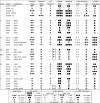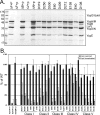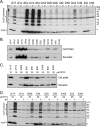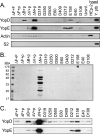Mutations in the Yersinia pseudotuberculosis type III secretion system needle protein, YscF, that specifically abrogate effector translocation into host cells
- PMID: 17071752
- PMCID: PMC1797200
- DOI: 10.1128/JB.01396-06
Mutations in the Yersinia pseudotuberculosis type III secretion system needle protein, YscF, that specifically abrogate effector translocation into host cells
Abstract
The trafficking of effectors, termed Yops, from Yersinia spp. into host cells is a multistep process that requires the type III secretion system (TTSS). The TTSS has three main structural parts: a base, a needle, and a translocon, which work together to ensure the polarized movement of Yops directly from the bacterial cytosol into the host cell cytosol. To understand the interactions that take place at the interface between the tip of the TTSS needle and the translocon, we developed a screen to identify mutations in the needle protein YscF that separated its function in secretion from its role in translocation. We identified 25 translocation-defective (TD) yscF mutants, which fall into five phenotypic classes. Some classes exhibit aberrant needle structure and/or reduced levels of Yop secretion, consistent with known functions for YscF. Strikingly, two yscF TD classes formed needles and secreted Yops normally but displayed distinct translocation defects. Class I yscF TD mutants showed diminished pore formation, suggesting incomplete pore insertion and/or assembly. Class II yscF TD mutants formed pores but showed nonpolar translocation, suggesting unstable needle-translocon interactions. These results indicate that YscF functions in Yop secretion and translocation can be genetically separated. Furthermore, the identification of YscF residues that are required for the assembly of the translocon and/or productive interactions with the translocon has allowed us to initiate the mapping of the needle-translocon interface.
Figures








References
-
- Amann, E., B. Ochs, and K. J. Abel. 1988. Tightly regulated tac promoter vectors useful for the expression of unfused and fused proteins in Escherichia coli. Gene 68:301-315. - PubMed
-
- Blocker, A., N. Jouihri, E. Larquet, P. Gounon, F. Ebel, C. Parsot, P. Sansonetti, and A. Allaoui. 2001. Structure and composition of the Shigella flexneri “needle complex”, a part of its type III secreton. Mol. Microbiol. 39:652-663. - PubMed
Publication types
MeSH terms
Substances
Grants and funding
LinkOut - more resources
Full Text Sources
Other Literature Sources
Molecular Biology Databases
Miscellaneous

